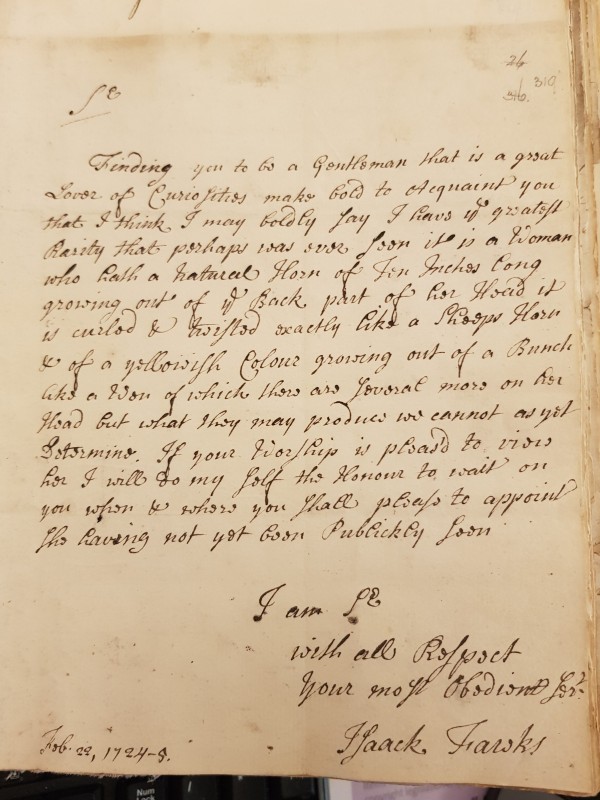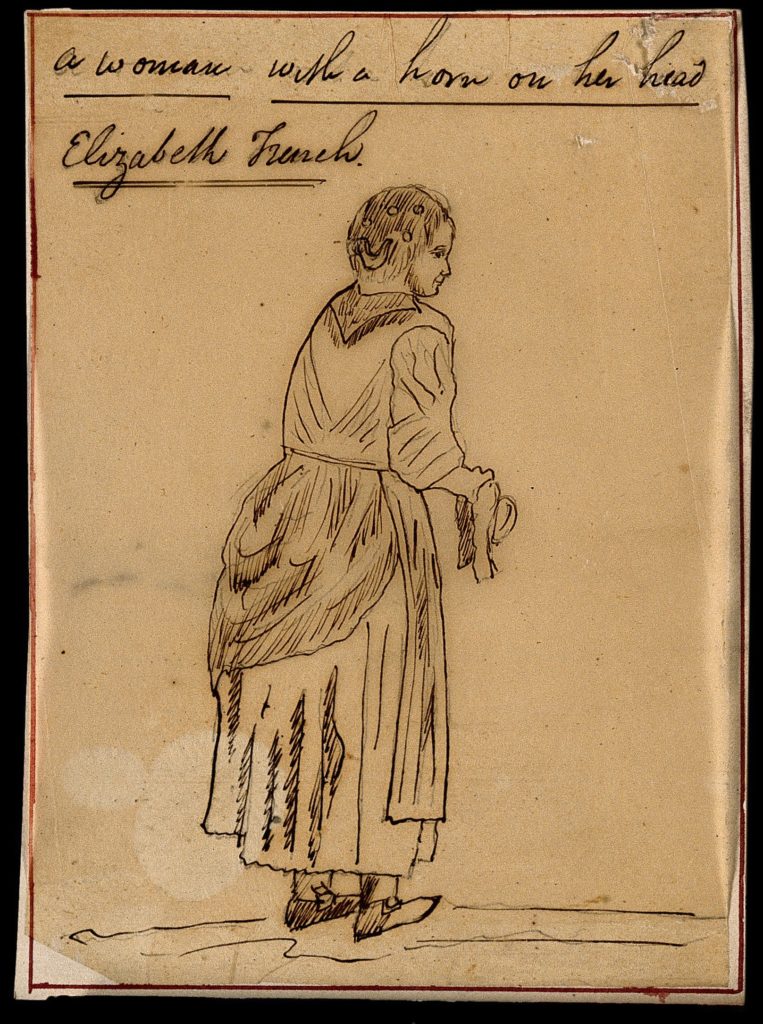Henry Barham Sr. to Hans Sloane – November 21, 1717
Item info
Date: November 21, 1717 Author: Henry Barham Sr. Recipient: Hans SloaneLibrary: British Library, London Manuscript: Sloane MS 4045 Folio: ff. 68-71
-
Language
English
-
Library
British Library, London
-
Categories
Medical, Scientific, Trade or Commodities, Travel
-
Subjects
Botany, Experiments, Jamaica, Mineral Waters, Mining, Precious Metals
-
Date (as written)
November 21, 1717
-
Standardised date
-
Origin (as written)
Carter Lane
-
Others mentioned
Dr Smallwood
-
Patients mentioned
Black Man
Original Page

Transcription
[fol. 68] Worthy Sr The Kind Reception of my Last Incourages me to goo on with this, wch Relates to A Cold Water wch I mentioned in my last at St Faiths in ye Parrish of St Johns of Guanaboo about 14 Miles from St. Iago dela Vego: the Tryalls I made of it in About 18 years Past, since wch I have lost most of my Notes and Observations I made Uppon it but what Remains in my memory I shall freely Impart: Walking along in a Small River at St Faiths above said where the Banks of each side are very high and shaded with Pleasant Green Trees, I spied [?] Some Shineing Sticking to the sides of the Banks of ye River, their luster Obliged me to make a farther search into the Banks: wch I found (after A Thin Clay bed was taken off) as it were A perpend=icular Wall of Square Fleaky Stones as it Placed by Art with some Clefts or large partments [?] where was as if Thrust in; Beds of White and Blew Morter, wch Upon handling Stuck Close to the fingers like Stiff Clay smelling So Strong of Sulphur enough to strike one down when first taken out of ye Rocks; wch was full of fine Glitte=rring Particles and some Lumps as bigg as the largest Diamond and when washed Clean from ye Earth Appeared very bright and Glittering like Pollisht stool or that Oar (the Spaniard Calls) Espajado: Upon further search=es into ye Bank wee found a large shelf (as Miners Call it) or Veins of Oar Continguous one to the Other about a yard Broad about 11 or 12 in Number of Divers Colours but Cheifly Blewish or Black, like Spanish Oar Called Soroches or Tacana and Running or Dipping Down inwards under the River: the more and lower wee Dugg the larger the Veins appeard: and when wee had Dugg about 4 or 5 foot Perpendicular A Water issued out of Several Veins so fast that wee were forced to give over our Inquisitive Search: (unless wee had Proper Ingions or Instruments to Clear it) wch if wee had and gone on I on not but Wee had come at A Rich mine And in this Water I made my Observations as followeth: The first think I took Notice off was that A Negro man that had a very Great Swelling on His Legg who working in the mine was Accidentally Cured by standing in that Water: The Negro seeing that He put in A Clean and Bright peece of Silver into this Mineral Water and it Immediately Turned it off a Copporous Colour this put me Upon a farther Inquiery into the Nature and quality of the Water, and Here I was at a Stand and Puzzled how to make an estimate or General Judgment of ye Water: for Observing a Number of Small Streams coming through Several and Different Mineral Veins Judged that each Stream might partake of that quality the mineral was off, and as some veins were more sulphurous Other more Saline, there must be A Strange Mixture of Boath: but Upon Tryal with Galls would but barely Ting [word missing] Turn Black Notwithstanding and of the Veins being Obviously Different from the Rest and Upon Trying that by its self found it to Superabound in Salt: the manner I Tried it is as followeth I took about A pound of the Oar Clean Washed Dryed and put it in A Crucible and gave it A Strong Heat Stirring it until all its Brightness Disappeard, and when Cold I put it into a Glazzed Pot ouring on it A quart of Water Stirring it very Well and when Settled Decanted of the Clear Water into wch I put in about 8 grains of Galls wch Turned the Water as Black as Ink in 15 minutes time and by Evaporation and Crystallization Could gaine A pure fine Copporous Salt or Green Vitrial like al Martis: But I Could not doo see with any of the Rest of the Veins wch seemed all to abound with Sulphur and would not Tinge, or if they had any salt it was not Ferruginous but more of the Nature of those in the Hot Bath I mentioned before: and may be Judg accordingly [several words blurred] Mineral Water at St Faiths abounds more of Sulphur than of Salts and to Inquier into the Nature of the Sulphur it abounds with is A Difficult Matter, every Mineral or Metal (as is Said) to have its Peculiar Sulphur wch is Called by Some Its Masculine Seed and Nature First [fol. 69] First Agent in all Generation of Metals come Near to Elemental Fire Differing from Common Sulphur but this by Way of Digression and to Returne: I took A Small quantity of the Oar in General without Respect to any Particular Vein and Sublimed it of which I gained a large quantity of Red Flowers like those of Antimony with its undigested Mercury (and therefore by some is Called its Malignant Sulphur I also took about 12 ounces of a Particular Vein like that Oar the Spaniards Call Soroches wch by Fuseing it with A Strong Fluxing Fire in A Wind Furnace I Could Gett one ounce of A Pure Regulas as bright as any Starr of Antimony wch after 3 or 4 Meltings I gave A Negro Woman 8 grains of it, wch gave Her 9 or 10 Stools and one large Vomit bringing Up a large Stomack Worm and after she had took the same dose 3 or 4 times it altogether wrote downwards and took away A very Large Tumor She had Upon Her Thigh for some time before; So that it appears (in my Judgment by those Tryalls and some Others I made upon this St Faiths Water to be Impregnated with an Antimonial Sulphur A Vitriolick Salt, and if So I Leave you Sr: to Judge who is a better Judge than I off the Great Virtue and efficacy this Water must have in most Distempers incident to Human bodys This I Can assure and Assert that I saw an Hydropicall Person So Swelled that None of His Cloathes would come on Him and was Carried up to St Faiths in Blanketts to Drink this mineral Water who was in A Short time brought So long or small that His common Wareing Cloathes were much to bigg for Him and Remain in A good State of Health many years after it, I also know one Mr Smallwood Nephew to that Dr Smallwood you Mention in page 55 Introd: that was Cured of His Wound by a Poisned Arrow with Contrayerva the Virtues of Wch I Shall mention Hereafter This Smallwood was so swelled Upwards that He Could not Lye Down in His bed was Cured in six Weeks time by Drinking St Faiths Water Another Gentleman that Labourd under an Ascites was Cured by Drinking this Water at 30 Miles Distance only Now and then when the Water Did not Work by Stool (for it Never fails Working by Urine) an ounce or two of Sal Nitro Dissolved in the Mineral Water wch would give Many Watery Stools for 3 or 4 Days together Many Other Cured I see performed by this Wonderfull Medecinal Water to Tedious Here to Insert and May I Not Now ask the Question without offence since Jamaica so much abounds with Mines and Minerals why some of them if they were Nicely search[ed] or Lookt into might not be as Rich as any of their Neighbours: Mounsr. Galdy affirmed to me A little before I Left Jamaica that He had been up at Hyspaniola where the French had lately found a Rich Silver Mine; it is Certain the Mountains and easternmost Part of the Island of Jamaica Abounds with mines and Minerals and are frequently found more and more wch occasions as (some say) the Night Breezes to be so unholsom Raymundas saith that Vitriol is very Near A kind to Gold and hath Same Original and Principle its Certain there is A great Deal of Excellent Sulphur in Vitriol Paracelsus Accounts it A 3d part of Physick: than as to Antinomy wch is Another Quality The Island Abounds with Valentino Sayeth that its Sulphur is Equavilent to Potable Gold: and the Embry of Mettals and is found in Oruro Upon the [fol. 70] Upon the Main in Peruo in their Silver Oars and Why then Should wee not have Silver Oars in Jamaica Since wee have the same MIenralls with all the Symptoms they Carry and found in Silver Mines: (but this by the By) There is Near Round Hill in Camp Sevanna in the Parish of Vero a little Distant from Milk River (wch is very Brackish) 3 or 4 little Pitts or Holes of Water comeing from under the Round Hill wch Stands by its self in A Plain Sevanna Noo Other mountain being Near it in 8 or 9 Miles its Many Hundred feet High with a Blutt [?] Top: wch Water is a little Hotter than Blood Running ye Veins and in Cryed Up Mightly for Curing of Ulcers Achs and Pains, but Upon Strickt Inquiry I found it more Opinion then Matter of fact and by what Tryalls I made off it it Abounded with Common Marine Salt for out of 16 ounces of the Water I Could Gett six Drams of A Square grained Salt and noo appearance of Nitro as Some People would have it: as for its Warmth or Heat I Cannot Account for unless its Accasioned by a Rapid Motion it seems to have in the mountain by its Noise it makes within wch mountain is Running you mention Introd: p: 11 the Salt Water made into Salt by the Heat of the Sun wch was soo in your time, But Since the Earth quake in 1692 was Observed that there is no Such Salt to be found the Reason (as some say) that the Earthquake broak up the foundation of those Places and Destroyed the Rock of Salt its self whch was supposed the Seed to Lye in Which Turned the Rest of the Heating Waters with the Heat of the Sun into Salt. Wch is now wholly Lost those Place Remaining ever Since Over flowed and Now Turn to Salt: Much mony hath been Spent Since to make Salt but no Noo Purpose: and Now I Shall Leave these Hydrophanticall Observations to your serious Consideration and Candid Jud [fol. 71] Judgement and Opinion of these my mean undertakeing and as Received shall goo on; I wallways Remaining your most Humble Devoted Servant to Command at all times and in all Places Henry Barham Carter Lane November 21: D: 4: 1717
Henry Barham (1670?-1726) was a botanist. He lived in Jamaica and corresponded with Sloane on the plant and animal life of the island. Parts of Barham’s letters to Sloane appeared in the latter’s Natural History of Jamaica (T. F. Henderson, Barham, Henry (1670?1726), rev. Anita McConnell, Oxford Dictionary of National Biography, Oxford University Press, 2004 [http://www.oxforddnb.com/view/article/1374, accessed 13 June 2011]).
Patient Details
-
Patient info
Name: N/A Black Man
Gender:
Age: -
Description
He had a swollen leg.
-
Diagnosis
Barham believes the cure had something to do with the mineral content of the water.
-
Treatment
Previous Treatment:
He dipped his leg in the bath waters near St Iago de la Vega and it was miraculously cured.
Ongoing Treatment:
Response: -
More information
-
Medical problem reference
Worms, Stomach, Inflammations





